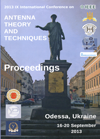Analytical methods of electromagnetic field theory in student study
DOI:
https://doi.org/10.1109/ICATT.2013.6650796Keywords:
electromagnetic field theory, vector field intensities, Maxwell equations, differential form, general wave equationAbstract
Here, it is proposed the short outline of the special master course on the directions related to radio engineering and telecommunications. The given topic concerns some more or less new analytical methods on the explicit solution and mathematical simulation of relevant problems in technical electrodynamics basing on the symmetrical differential Maxwell system.
Those aforesaid techniques deal with the operator analogy of algebraic Gauss method and inverse matrix operator construction. The latter generates solvability criterion of the symmetrical inhomogeneous Maxwell system in terms of equivalence to the general wave PDE (partial differential equation) with respect to all unknown electromagnetic field intensities. The proven theorem allows formulating relevant boundary problems that describe mathematically wave propagation in the various media. Such problems are solved explicitly using the classical integral transform method. Advantages of present procedures are their simplicity in direct applications including arbitrary finite dimensional systems of PDEs and consideration of non generalized functions.
References
IVANITCKIY, A.M. Dependence of the third and fourth Maxwell equations upon the first two equations with arbitrary excitation of electromagnetic field. J. Scientific Works of ONAT, 2004, n.2, p.3-7.
SOMMERFELD, A. Electrodynamik. Band III, 1st. ed. Leipzig: Akademische Verlagsgesellschaft Geest & Prtig K.-G., 1949.
IVANITCKIY, A.M.; DMITRIEVA, I.Y. Diagonalization of the "symmetrical" system of differential Maxwell equations. J. Scientific Works of ONAT, 2007, n.1, p.15-24.
DMITRIEVA, I. Some cases of electromagnetic wave propagation in terms of analytical study. Proc. of 11th Int. Symp. on Signals, Circuits and Systems, ISSCS, 11-12 Jul. 2013, Iasi. IEEE, 2013, p.1-4, doi: http://dx.doi.org/10.1109/ISSCS.2013.6651207.
KUROSH, A.G. General Algebra Course. Moscow: Nauka, 1975, [in Russian].
TRENCH, W.F. Introduction to Real Analysis. Pearson Education, 2003, ISBN: 0-13-045786-8.
VON KAMKE, E. Differentialgleichungen. Losungsmethoden und Losungen, 6th Verbesserte Auflage. Leipzig: Gewohnliche Differentialgleichungen, 1959.
ANGOT, A. Complements de Mathematiques. Paris: A l'Usage des Ingenieurs de l' Elektrotechnique et des Telecommunications, 1957.
DMITRIEVA, I. Mathematical solution of some industrial problem in technical electrodynamics. J. Bulletin of the Transilvania University of Brasov, 2012, n.5, p.103-110.
DMITRIEVA, I. Operator diagonalization procedure and its numerical realization in the framework of technical electrodynamics. Proc. of 3rd Int. Conf. on Econophysics, Complexity, etc., ENEC, 2010. Bucharest: Victor Publishing House, 2010, v.3, p.291-300.
DMITRIEVA, I. Industrial problems of technical electrodynamics and analysis of the inverse matrix operator existence for the "symmetrical' differential Maxwell system. Proc. of 4th Int. Conf. on Econophysics, Complexity, etc., ENEC, 2011. Bucharest: Victor Publishing House, 2011, v.4, p.9-18.
DMITRIEVA, I.Y. Mathematical modeling of electromagnetic wave propagation in inhomogeneous medium. Proc. of XXXIIIrd Int. Sci. Conf. on Electronics and Nanotechnology, ELNANO, 16-19 Apr. 2013, Kyiv, Ukraine. IEEE, 2013, p.147-150, doi: http://dx.doi.org/10.1109/ELNANO.2013.6552083.
TRANTER, C.J. Integral Transforms in Mathematical Physics. New York: Methuen and Co. Ltd.; London & John Wiley and Sons, Inc., 1951.
RADON, J. Uber die Bestimmung von Funktionen durch ihre Integralwerte Langs Gewisser Mannigfaltigkeiten. Berichte Sachsische Akademie der Wissenschaften, 1917, v.29, p.262-277.
VAINSHTEIN, A.A. Electromagnetic Waves. Moscow: Radio I Svyaz, 1988 [in Russian].
NIKOLSKIY, V.V.; NIKOLSKAYA, T.I. Electrodynamics and Radio Wave Propagation. Moscow: Nauka, 1989 [in Russian].

